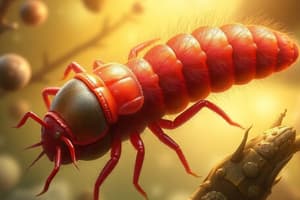Podcast
Questions and Answers
What is the function of the scolex in cestodes?
What is the function of the scolex in cestodes?
- Digestive system
- Main organ of attachment to definitive host (correct)
- Segment of maturation
- Region of growth
What is the intermediate host of Taenia saginata?
What is the intermediate host of Taenia saginata?
- Pig
- Cattle (correct)
- Human
- Sheep
How do humans acquire Taenia saginata infection?
How do humans acquire Taenia saginata infection?
- Through contaminated water
- Through direct contact with infected cattle
- By ingesting improperly cooked or raw beef containing infective larva (correct)
- Through airborne transmission
What is the approximate time for the larva to mature in the small intestine?
What is the approximate time for the larva to mature in the small intestine?
What is the maximum length that Taenia saginata can achieve?
What is the maximum length that Taenia saginata can achieve?
What can irritate Taenia saginata and cause the passage of proglottids?
What can irritate Taenia saginata and cause the passage of proglottids?
What is the treatment for Taeniasis?
What is the treatment for Taeniasis?
Which of the following tapeworms can complete its entire life cycle in a single host?
Which of the following tapeworms can complete its entire life cycle in a single host?
What is the diagnostic method used to differentiate species of tapeworms?
What is the diagnostic method used to differentiate species of tapeworms?
What is the consequence of the death of larva in cysticercosis?
What is the consequence of the death of larva in cysticercosis?
What is the characteristic of the eggs of Diphyllobothrium latum?
What is the characteristic of the eggs of Diphyllobothrium latum?
What is the common finding in Diphyllobothriasis?
What is the common finding in Diphyllobothriasis?
Study Notes
Cestodes (Tapeworms)
- Characterized by segmented, ribbon-like morphology
- All are hermaphroditic
- Lack nervous and digestive systems
- Morphology consists of:
- Scolex: main organ of attachment to definitive host
- Neck: region of growth
- Segments or proglottids: become more mature distally, with most distal segments being gravid
Taenia Saginata (Beef Tapeworm)
- Intermediate host: cattle
- Definitive host: human
- Life cycle:
- Eggs go into blood vessels within cattle's intestines and are transported to skeletal muscles, where they develop as larvae (cysticerci)
- Infection occurs through ingestion of improperly cooked or raw beef containing infective larva (cysticercus)
- Maturation occurs in small intestine, taking approximately 3 months
- Can grow up to 10 meters in length
- Adult tapeworms are irritated by alcohol, leading to passage of proglottids after consumption
- Causes Taeniasis, leading to diarrhea, abdominal pain, loss of appetite, and weight loss
- Laboratory diagnosis: examination of fecal specimens
- Treatment: Praziquantel
- Prevention and control: proper waste disposal, sanitation practices, and adequate cooking of beef; freezing of beef meat for 10 days can kill encysted larvae
Taenia Solium (Pork Tapeworm)
- Humans are both intermediate and definitive hosts
- Life cycle:
- Ingested worm eggs hatch in small intestine, burrow to intestinal wall, and disseminate to various organs
- Infection occurs through ingestion of improperly cooked or raw pork meat containing infective larva (cysticercus cellulosae)
- Diagnostic methods:
- Stool examination
- Perianal swabs
- Examination of gravid proglottids flattened between two glass slides
- Injection of India ink through genital pore to count lateral branches of uterus
- CT scan, MRI for neurocysticercosis
- Ophthalmoscopy for ophthalmic cysticercosis
- Causes Cysticercosis, a parasitic infection caused by larvae of tapeworm
Pathogenesis of Taenia Solium
- Minor intestinal damage from adult tapeworms
- Irritation at site of attachment
- Entangled proglottids may cause intestinal obstruction
- Cysticerci can develop in various tissues, including striated muscle, brain, subcutaneous tissues, eye, heart, lung, and peritoneum
- Living cysticerci can cause inflammation or death, leading to inflammation and calcification
Diphyllobothrium Latum (Broad Fish Tapeworm)
- 1st intermediate host: copepods (Cyclops and Diaptomus)
- 2nd intermediate host: fish
- Longest medically important tapeworm
- Has two elongated sucking grooves for attachment
- Has operculated eggs (unique among cestodes)
- Causes Diphyllobothriasis, characterized by:
- Abdominal pain and diarrhea
- Hyperchromic, megaloblastic anemia (due to vitamin B12 deficiency)
- Thrombocytopenia and leukopenia
- Treatment: Praziquantel
- Criteria for cure: recovery of scolex
Hymenolepis Nana (Dwarf Tapeworm)
- Smallest tapeworm
- Most frequently found tapeworm in developed countries
- Common in orphanages, day care centers, and mental institutions
- Can complete its entire life cycle in a single host (no intermediate host required)
- Ingestion of infected rice or flour beetles with cysticercoid larvae can cause infection
- Eggs are directly infectious for humans and can pass in stool or reinfect small intestine (autoinfection)
- Eggs have 8-10 polar filaments and six-hooked larva
- Treatment: Praziquantel
Studying That Suits You
Use AI to generate personalized quizzes and flashcards to suit your learning preferences.
Description
Learn about the morphology and features of cestodes, also known as tapeworms. Understand the importance of scolex, neck, and proglottids in their structure. Discover how they attach to definitive hosts and their unique characteristics.




